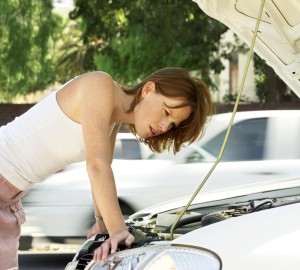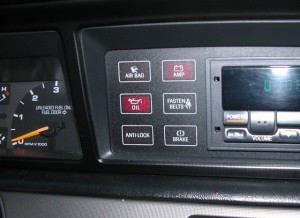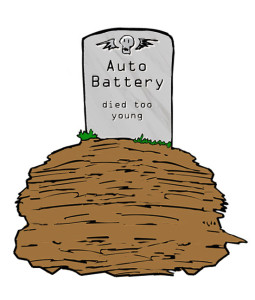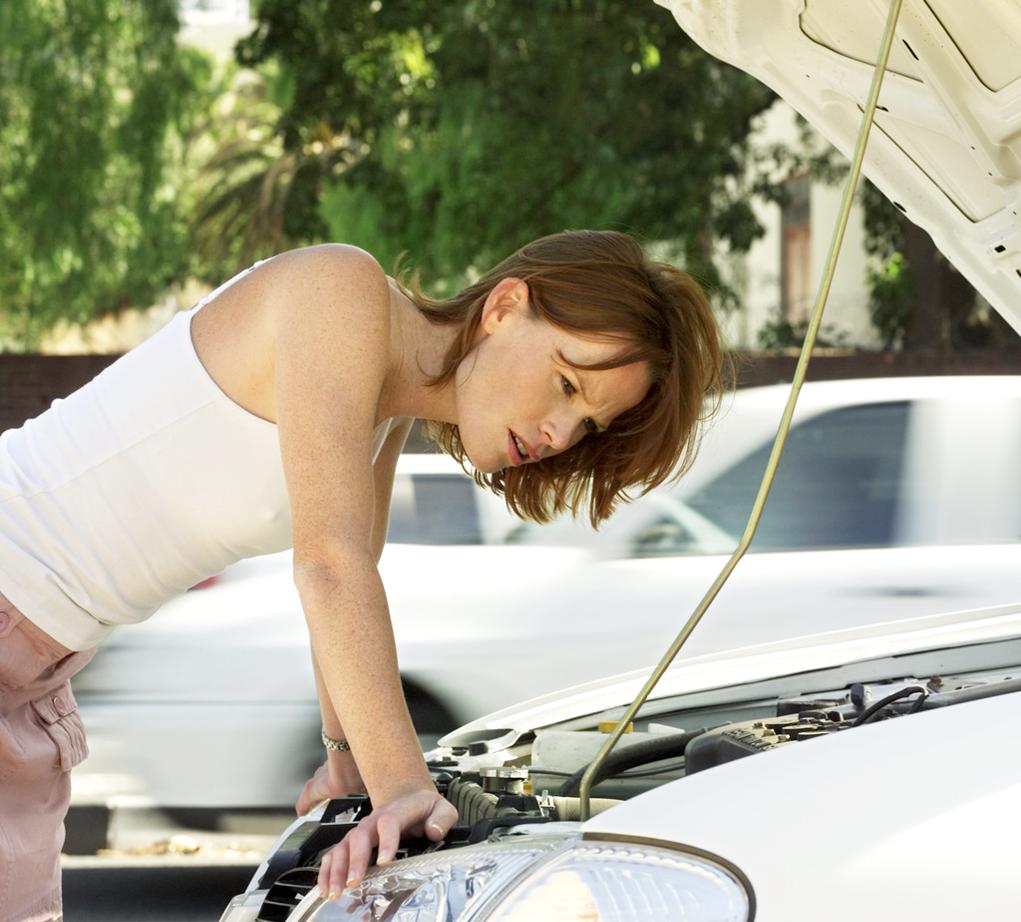If your car’s engine starts making a “funny noise,” should you be worried?
It depends on the noise!
Some noises are harbingers of real trouble. Others are usually nothing to worry about. Let’s take a look at some examples of both kinds of noises:
* Light clattering sound when you first start the engine –
A rapid tap-tap-tap-tap (or tick-tick-tick) sound that goes away within seconds after the engine is first started after it’s been sitting overnight (or longer) is usually no cause for concern . . . provided the sound does go away within seconds after the engine is started.
What’s happened is all the oil has settled to the very bottom of the engine and it takes a moment for the engine to build oil pressure; the short-lived noise you hear goes away as soon as oil reaches the parts (typically, the valvetrain) that were crying out for oil. The noise is normal, provided it is very brief – a few seconds – and provided you only hear it at cold-start, when the engine has been sitting idle for awhile. It is most common on cold mornings, when the car has been left outside all night. The oil is thicker and harder to pump, due to the cold.
If the clattering sounds does not go away a few seconds after start-up – especially if it’s present when the engine is fully warmed up – it could be a more serious problem. The first thing to check is the oil level. Pull out the dipstick and look at the hashmarks. If it’s low, that could be the cause of the trouble. If it is low – and the noise goes away once the level is topped off – you’re all set. But remember to find out why it’s low. There is either a leak (look for puddles underneath the car) or the engine is using (burning) oil excessively. It should not be necessary to top off the oil level more than once a month. If you find that you’re having to do that, you’ve got another problem on your hands.
If the oil level is not low, the next thing to check is oil pressure.
If the car has a gauge in the instrument cluster, take a look at it while the engine is idling (never “race” the engine if you suspect mechanical problems, especially lubrication related mechanical problems). Your owner’s manual can give you specifics as to what constitutes a “normal” oil pressure reading for your particular car, but – generally – the needle should be to the right of Low and (in most cases) in the middle of the gauge, between “L” (for “low”) and “H” (for high). If the gauge registers little to no oil pressure and the engine is making noise, turn the engine off immediately. Have the car towed to a shop you trust. Do not drive it. Do not run the engine at all until the problem is found and fixed. It might just be a bad oil pump, which isn’t that big a deal. But if you run the engine with a bad oil pump, you risk killing the engine, which is a big deal.
If the car has an idiot light for oil pressure, it ought to be illuminated just before you start the engine (key in “run” position) but quickly go out once the engine actually starts. If it stays on, turn off the engine – and call The Man.
* Squealing and screeching noises –
Several possibilities here, but the most typical are drive belt troubles (loose or misaligned) or accessory troubles (e.g., a problem with the power steering pump such as low fluid level). Often, the noise will get worse if you rev the engine. Sometimes, the noise is constant.
First thing to do is stop the engine, pop the hood and have a look. Check for signs of leaks and seeps around the power steering pump. This accessory is the only accessory that will have a fluid reservoir with a removable cap or dipstick. If you see signs of leakage – and reddish fluid, which is the usual color of power steering fluid – it’s a clue your problem may be a failing power steering pump. Or failing power steering pump hydraulic lines. If fluid is leaking because of failing lines, the pump will eventually run low, then dry – and it will squeal. Check the fluid level of the reservoir. If it’s low, you’ve likely found your trouble. Topping it off should quiet the squeal . . .temporarily – until the pump runs low again. You’ll need to have it looked at, but it’s usually not a “right now” thing. Just keep spare fluid on hand for top-offs until you can find time to have the pump (and lines) checked out.
If the power steering pumps seems leak-free and is properly topped off, the next most likely culprit responsible for The Squeals is a loose or misaligned drive belt (or pulley). A quick test that requires no tools is to buy a can of WD-40 aerosol lubricant (buy a can at any auto parts or hardware store) and – with the engine idling – shoot a light spray at the various pulleys and belts (many modern cars have just one “serpentine” belt that drives all the accessories). If the squeal goes away, you’ve found your problem – and the shot of WD-40 might have permanently cured it. If not, you may have to have a mechanic check the drive belt(s) and pulleys. Either way, this is – usually – not an urgent problem. Just an annoyance. With one caveat: If your car has one of those “serpentine” belts and it fails, you will lose all your accessories, including the alternator – it makes the electricity your car needs to run – and water pump – without which your car’s engine will very quickly overheat and you will be stuck. The one big advantage of older-design cars that have a single belt for each accessory is that you can often continue driving if the belt that failed wasn’t one that drove a critical accessory, such as the water pump or the alternator.
* A “click” noise… followed by no noise at all –
This is usually one of two things: Either a bad battery, or a bad connection. The battery might not have sufficient power to turn the starter motor, which starts the engine (in modern cars, the starting voltage must be above a certain point – as high as 14.4 Volts – or the computer will not allow the engine to start) or there might be sufficient power in the battery but it’s not getting to the starter due to a poor connection.
First thing to try is checking the connections at the battery. Feel by hand whether they’re loose; sometimes, jiggling them will result in a “lights on” (and ready to start) condition, like magic. But it’s not magic. You’ve just uncovered a poor connection – and re-established a good connection. You will probably need to either tighten the cable clamps at the battery terminals, or replace the cables, if the clamps have lost their ability to tightly grip the battery’s terminals It may also be necessary to clean the terminals (and cable clamps). Use a wire brush/terminal cleaning tool for this – which you can buy at any auto parts store for less than $10. Once clean, spray the terminals/clamps with WD-40 (the miracle in a can) which will displace any lingering moisture (that’s what the “WD” stands for) and also leave a protective coating on the exposed surfaces.
If jiggling the wires – and cleaning the connections at the terminals – doesn’t do anything, and the battery is more than two years old, the next most likely culprit for your no-start blues is the battery. But don’t chuck it just yet. First, get it tested. Most auto parts stores will do this for free – and if the battery is dead and did have warranty (most do) you will usually get at least some of your money back in the form of a store credit toward your new battery. Assuming, of course, that you saved the receipt for your old battery. You did save your receipt, right? I always leave my receipts in the glovebox of the car, which is the best place to find the thing if the battery ever prematurely buys the farm.
Next time, we consider some smells – and what they portend.
Throw it in the Woods?
Spread it via Twitter: LibertarianCarG (they would not let me have “guy”).
And:
We depend on you to keep the wheels turning. If you value alternatives to the MSM, please support independent media. Our donate button is here.
For those not Pay Pal-inclined, you can mail us at the following:
EPautos
721 Hummingbird Lane SE
Copper Hill, VA 24079











That’s exactly what I am looking for. Thanks for this post.
Thanks for the information about checking the oil level if the clattering sound doesn’t go away after a few seconds. When I start my Subaru Impreza, I hear a tapping noise that goes away quickly, but it starts again when I start driving, especially when I turn. Maybe I should have an auto repair shop check the oil level to see if a lack of fluid is causing the sound.
Hi Hannah,
It’s a good idea to keep track of oil levels in any car! Also to become used to the normal sounds your car makes so that you will notice abnormal sounds – and take steps to find out why the sound is different. Some engines are noisier than others, incidentally. Ticking and clattering that is abnormal in one make/model may be normal in another.
Hannah, does it not have an owners manual? It’s not rocket science to check the oil.
This reminds me of my wife’s mother requiring all her children to learn to change a flat before they could drive the car. A smart woman and something that worked, at least with my wife. Later in life I’d teach her to change a flat on a big rig.
My tick tick tick was a CD stuck in my CD player trying to get out………….
How did you get it out, mine does the same thing
I used to have to hammer fist the dash in my 06 Tucson that I played my CDs in until it started eating them. Press eject then give it a punch and it would come out.
I’ve had two starters fail within the past two years (’95 Chevy Caprice and ’98 Ford Econoline) and the symptom was the same: Slow starting. Not a fast spin-up of the engine but a “rump-Rump-RUmp-RUMP” then fire. Thankfully, both cars were front engine rear drive layouts, and changing the starter was seriously four bolts and the connector! Whew…
RE: “Thankfully, both cars were front engine rear drive layouts, and changing the starter was seriously four bolts and the connector! Whew…”
I hear ya.
Some 4×4’s Suck Big Time in that department. I Only Wished they were like that.
“four bolts and the connector!” – That was, ‘The Best thing’ about the old Ford trucks I had. Even when it was -80′ below zero outside while changing the starter, it wasn’t too bad, even if the gravel poked you in the back and you had to go inside every 12 minutes to warm up from touching the ice-cold ratchet.
Shit builds character… or, something like that?
/Pointless reminiscing rant /OFF.
P.s.
My truck smells like gas, just a tad.
It’s not the first time I didn’t stop driving a vehicle for that reason.
I guess that means I’m lucky?
… I don’t feel lucky.
…Did I ever tell you about this time I put a plastic boat gas tank in the trunk to replace the leaky gas tank and ran a line…
sorry… it’s a slightly red-neck story with no real point.
… Except that’s the car I ran out of gas in and the cops called me and asked,” Is this your car? Come pick it up.” Then I did, and…. /Seriously, End.
It has Nothing whatsoever to do with those guys who kicked the shit out of the cop after he pulled them over for minor bullshit and he tried turning it into something much more… [Oh, Jean, You’d a liked them guys.] It Never made the police report in the local paper. Imagine that? I wonder why?
Hi Tom,
Yup!
Pulling/replacing a starter in a front-engined/RWD car is usually hand-tool-doable by just about anyone with some patience and a floor jack.
eric, cruising along one day in my pickup it just quit….like I turned off the key. I had a good suspicion of the problem so I got a ring terminal to fit a solenoid wire and a crimping tool. Sure enough, wire is hanging there broken off from the terminal from my endless pasture driving. The worst of it though was the solid grass burrs and cut off mesquites I had to endure to get under it. When you get out from that position you can grab the tail of your shirt and try to pull it tight as far away from your body as possible. Once you think you’ve gotten everything unplugged that is going to be unplugged you can take your shirt off and remove all the burrs from it and get somewhere as soon as possible to have somebody pull the rest out of your back…..or just live the rest of the day with it. Whooeee, you’ll have some mighty sore spots by day’s end. I try to carry a new tarp in the package and only open it enough to lay on. If you have two big floor mats they can help some too….even one. I’ve even sat down on the passenger side of the seat to pull burrs from my pants and my dog licked my back which felt pretty good at that point. Maybe some folks don’t have this problem but I’d bet I’m not the only one who looks at a barditch with dread. I was just glad I hadn’t stopped on a bumblebee nest.
Oh yeah.. Some older cars/utes that have a squealing noise coming from what seems to be the alternator/water pump belt, actually have a little hole in the water pump casing near the pulley/fan so the bearing can be oiled occasionally, although these are rare nowadays.
Batteries usually last around 4 years on average, but I’ve seen one last 7 years and one only a few hours. Best way to check a suspect battery is load testing.
A new battery will usually have about 12.8 volts fully charged and unloaded. Cranking the engine it should drop to about 11.5 volts.
A battery near the end of its life can still show 12.8 or so volts unloaded, but the voltage drop under cranking will be more severe, down to 10 or even 8 volts. I’ve seen them drop to under 5, but from about 8 volts and under cranking usually isn’t even possible.
Lead-acid batteries (even the many variants such as ceramic etc.) will kark it pretty quick. It’ll be fine for years and one morning, it’ll start cranking slow, or fail to do much altogether. If you manage to get a jump-start, expect leaving work the same way you left home that morning. At the first sign of the battery becoming sluggish, get it checked out because they’re fickle creatures that rarely last a week after becoming sick.
See if you can find the manufacture date of your battery. It’s usually stamped on the negative terminal in letter-number format, for example “H9”. The “H” is the month starting from “A” and the “9” is the year starting at zero. Therefore, “H9” means the battery was manufactured September 2009 (or September 1999 if you found it laying in a dump somewhere). I’ll bet there are very few still in use from 2009 though.
If there’s no stamp on any terminal, then there’s either a sticker with removable numbers denoting the month and year.
Some don’t even have that, so when it comes to replacing batteries, oil filters and fuel filters, I always put the replacement date on them with a marker so there’s no guessing.
Goof stuff, Rev!
And, hey: I still have the original factory battery in my ’03 ZRX1200 (the one bike I bought new).
11 years – and still kicking! (Well, turning…)
Outstanding Eric. Let us know the voltage unloaded and under crank. Let’s see if it beats the oldest lead-acid forklift battery I ever met – 21 years. Notably, it was a pretty sick 24V 350kg lump of lead 😉
It’s possible to resurrect batteries if the plates are still ok. Eventually the lead plates crumble away and form a sludge at the bottom. This shorts out the plates. If the sludge is only oxides, then it can be flushed out and new acid put back in, but I wouldn’t put many bets on it.
Mostly the plates sulphate and become electrically inert over time. It’s possible to fix a battery like this by cycle-charging it at a high rate to shake off the sulphate.
Lead-acid batteries don’t like to be discharged – period. If they’re flat for a long time, or drained beyond 50%, expect their life to be shortened markedly. Don’t ever believe the “deep discharge” guff either.
Also, if the battery is dying for “no reason,” the cables are tight, etc., try cleaning the top of the battery. Had this happen back in the day, some minor leakage and/or just living on the coast had caused a “salt bridge” between the terminals, shorting out the battery and draining it.
I had a problem with a starter that acted intermittently and refused to start. Just a loud click sound. I found when that happened on my car with auto trans, I could just push the car in N, get it moving slowly, and then throw it into P, and hit the ignition switch immediately. Then I could get the car started normally (3.8L V6 GM). After 2 replacement starters, I took it to my mechanic. Fortunately, this time, it acted up big time while he had it in his shop, which 3 previous visits proved futile. He found it was the ground lead that attached to the motor mount that was loose. He tightened it up, and the problem disappeared. Several other problems also disappeared after that wire was tightened.
As for the oil problem, water in the oil can cause a loud ticking or clacking noise. I lost an engine that way.
Horse, I have one word for you…..Optima. Smudger has a few words for you…..I’m still spoiled and still hate all those other cats.
=)
http://thechive.com/2014/07/05/cat-saturday-34-photos-9/
Be well, you and yours.
Thanks Horse, I enjoyed that. The same to you and yours.